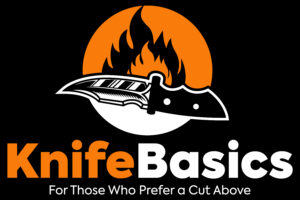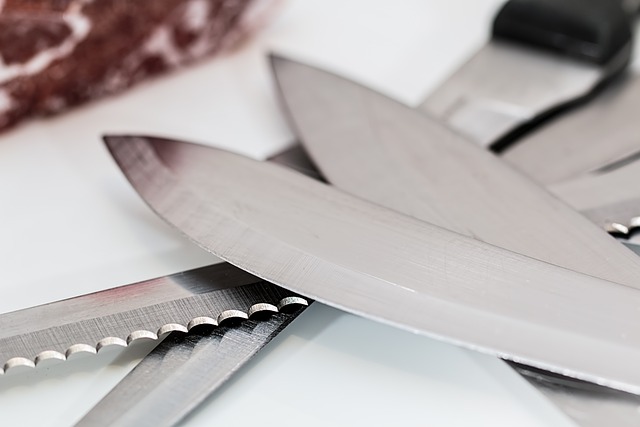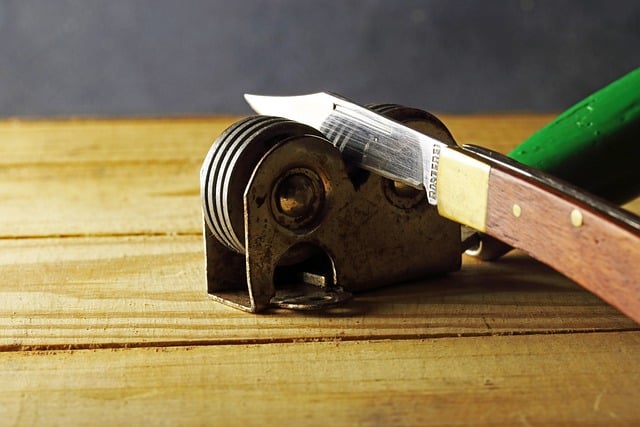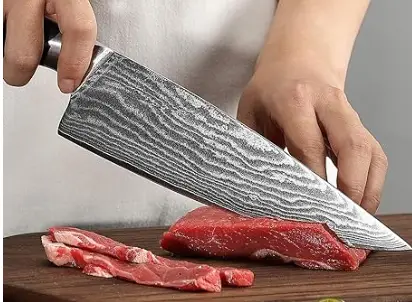Are you a knife enthusiast looking to take your craftsmanship to the next level? If so, then you’re in the right place! In this article, we will explore the world of stainless steel for knife making and guide you towards achieving sharp success with the best materials.
Choosing the right stainless steel for your knives is key to their performance and durability. With so many options available, it can be overwhelming to determine which one will work best for your needs. That’s where we come in.
Our team of experts has conducted extensive research to help you make an informed decision. We’ll discuss the different types of stainless steel, their characteristics, and their suitability for various knife-making applications. Whether you prefer a stainless steel with high hardness, corrosion resistance, or edge retention, we’ll provide you with all the information you need to make the perfect choice.
With our guidance, you’ll be able to create knives that not only look beautiful but also excel in cutting performance. Get ready to delve into the world of stainless steel for knife making and achieve sharp success like never before!
Understanding the importance of choosing the right stainless steel
When it comes to knife making, choosing the right stainless steel is crucial for achieving sharp success. The stainless steel used in a knife not only determines its performance but also its durability. With a wide variety of options available, it can be overwhelming to determine which one will work best for your needs. However, by understanding the different characteristics of stainless steel and their suitability for various knife-making applications, you can make an informed decision.
One of the key factors to consider when selecting stainless steel for knife making is its hardness. Hardness plays a vital role in the blade’s ability to retain its sharpness over time. Generally, the higher the hardness, the better the edge retention. However, it’s important to strike a balance, as extremely hard stainless steel can be more prone to chipping and breaking.
Corrosion resistance is another crucial aspect to consider. Knives are often exposed to moisture, acids, and other corrosive elements, especially in kitchen environments. Stainless steel with high corrosion resistance will be less likely to rust or corrode, ensuring that your knives remain in top condition for years to come.
Edge retention is also an important consideration. A knife with good edge retention will hold its sharpness for longer periods, reducing the need for frequent sharpening. This is particularly beneficial for professional chefs or avid outdoor enthusiasts who rely on their knives for extended periods without access to sharpening tools.
Factors to consider when selecting stainless steel for knife making
When selecting stainless steel for knife making, it’s essential to consider certain factors to ensure you choose the best material for your needs.
1. Intended Use: Determine the primary purpose of the knife. Will it be used for slicing, chopping, or delicate tasks? Different types of stainless steel excel in different applications, so understanding the intended use will help narrow down your options.
2. Hardness: Consider the desired hardness level based on the balance between edge retention and durability. Harder stainless steel typically has better edge retention but can be more prone to chipping and breaking.
3. Corrosion Resistance: Evaluate the environment in which the knife will be used. If the knife will be exposed to moisture or corrosive substances, opt for stainless steel with high corrosion resistance.
4. Sharpening Ease: Consider how often you are willing to sharpen your knife. Some stainless steel types are easier to sharpen than others. If you’re not confident in your sharpening skills or prefer a low-maintenance option, choose a stainless steel that is easier to sharpen.
5. Budget: Stainless steel for knife making comes in various price ranges. Consider your budget and find a balance between performance and affordability.
By considering these factors, you can narrow down your options and make an informed decision when selecting stainless steel for knife making.
Different types of stainless steel for knife making
There are numerous types of stainless steel available for knife making, each with its own unique characteristics. Let’s explore some of the most commonly used stainless steel types and their suitability for knife making applications.
1. AUS-8: A popular stainless steel choice due to its excellent balance of affordability, corrosion resistance, and edge retention. It is relatively easy to sharpen and is commonly used in mid-range knives.
2. VG-10: Known for its exceptional hardness and corrosion resistance, VG-10 stainless steel is a top choice for high-end kitchen knives. It offers excellent edge retention and is often used in professional chef knives.
3. S30V: S30V stainless steel is renowned for its superior edge retention and toughness. It is commonly used in high-quality folding knives and outdoor survival knives.
4. D2: D2 stainless steel is highly regarded for its exceptional hardness and wear resistance. It is commonly used in high-end custom knives and offers excellent edge retention.
5. 154CM: This stainless steel is known for its good balance of hardness, corrosion resistance, and edge retention. It is commonly used in both folding and fixed blade knives.
These are just a few examples of the many stainless steel types available for knife making. Each type has its own unique characteristics, so it’s important to consider your specific requirements and preferences before making a decision.
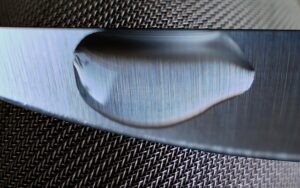
Pros and cons of each stainless steel type
While each stainless steel type has its own advantages and disadvantages, understanding the pros and cons can help you make an informed decision.
1. AUS-8:
– Pros: Affordable, good corrosion resistance, easy to sharpen.
– Cons: Lower edge retention compared to higher-end stainless steel types.
2. VG-10:
– Pros: Excellent hardness, corrosion resistance, and edge retention.
– Cons: Higher cost compared to other stainless steel types.
3. S30V:
– Pros: Superior edge retention, toughness, and corrosion resistance.
– Cons: More difficult to sharpen compared to other stainless steel types.
4. D2:
– Pros: Exceptional hardness, wear resistance, and edge retention.
– Cons: Can be more challenging to sharpen.
5. 154CM:
– Pros: Good balance of hardness, corrosion resistance, and edge retention.
– Cons: May not excel in specific areas compared to specialized stainless steel types.
It’s important to weigh these pros and cons against your specific needs and preferences when selecting stainless steel for knife making.
Testing and comparing stainless steel for knife making
When choosing the best stainless steel for knife making, it’s essential to consider real-world performance rather than solely relying on specifications. Conducting tests and comparing different stainless steel types as well as super knife steel types can provide valuable insights into their actual performance.
One common test is the Rockwell hardness test, which measures the hardness of stainless steel. This test helps determine the steel’s ability to retain its sharpness and resist deformation.
Another important test is the corrosion resistance test, which involves exposing the stainless steel to various corrosive agents. This test helps assess how well the steel can withstand exposure to moisture, acids, and other corrosive substances.
Additionally, conducting cutting tests can provide insights into edge retention and overall cutting performance. By comparing different stainless steel types side by side, you can determine which one performs best for your intended use.
- Multipurpose Knife Set: This kitchen knives set includes 8" Chef Knife, 8" Slicing Knife, 7" Santoku Knife, 8" Serrated Bread Knife, 5" Utility Knife, 3.5" Paring Knife, Kitchen Shears and 6 pcs Blade Guards
- Anti-rust coating: The healthy anti-rust coating protects the knife from oxidation and dishwasher safe, while the non-stick coating ensures the blades stay clean all day long
- Easy to carry: Each knife comes with a blade guard for safe, compact storage in your kitchen cupboard. These knives are also easy to carry when camping or storing in your RV
- Perfect Holiday Gift: Ideal for kitchen enthusiasts or new cooks, this knife set meets all cooking needs. It makes an excellent holiday gift for family, friends, lover and colleague
- Lifetime Warranty: Every knife set is backed by rigorous quality inspection, we provide a lifetime warranty for every customer, ensuring superior customer service and peace of mind with every purchase
- Set of 12 stainless steel knives for dining room, kitchen or restaurant use
- Simple design can mix and match with existing flatware, or add matching sets for full service for 12 (spoons and forks sold separately)
- Substantial weight; well-balanced flatware feels neither too light nor too heavy in the hand
- Dishwasher safe; for best results rinse before washing and within 2 hours of use
- 【Multi-Function Damascus Knife Set】 This 5-piece set includes 8" chef knife, 9" serrated bread & brisket knife, 7" santoku knife, 6" boning knife, and 3.5" paring knife for complete kitchen coverage. Effortlessly handles chopping, slicing, dicing, and mincing meats, fruits, and vegetables. Perfect for both home and professional kitchens, each blade excels in specialized tasks from precision trimming and bone removal to heavy-duty chopping, delivering exceptional versatility and performance.
- 【Premium High-Carbon Stainless Steel】 Made from 9CR18MOV Damascus steel knife blades (60±2 HRC), this knife set offers exceptional sharpness and durability. Featuring 67-layer forged construction and precision 15° blade grinding, each knife delivers razor-sharp edges with superior wear resistance and corrosion protection. Ideal for home cooks and professionals alike, combining Japanese craftsmanship with reliable performance.
- 【Ergonomic & Balanced Knife Handle Design】 Engineered for ultimate comfort and control, this knife set features a 3D ergonomic handle with enhanced non-slip performance that reduces hand fatigue and ensures safer use. Triple-riveted full-tang construction delivers superior balance, durability, and a secure hold for all hand sizes. Precision-weighted design enhances agility and cutting efficiency. Combining slip-resistant, long-lasting materials, these handles blend practicality with professional-grade performance.
- 【Fashionable & Functional Kitchen Knife Set】 A timeless design that blends practicality, durability, and style for every kitchen. Presented in an elegant ready-to-gift box, this set makes a thoughtful present for birthdays, housewarmings, or holidays. Perfect for culinary professionals, home cooks, and enthusiasts who value superior craftsmanship and performance. Combines traditional quality with modern elegance—ideal as a daily essential or meaningful gift offering exceptional value.
- 【Backed by Our Commitment】 Crafted to the highest standards, this knife set without block delivers reliable performance. We Craft It, We Use It, We Sell It - Expert Quality You Can Trust. Safe for hand washing and dishwasher use (hand wash recommended for maximum longevity). Simply wash and dry to keep blades sharp and corrosion-free. 24/7 Customer Support - We respond within 24 hours.
Recommended stainless steel grades for different knife types
The best stainless steel grade for a knife depends on its intended use. Here are some recommended stainless steel grades for different knife types:
1. Chef’s Knife: VG-10, S30V, or 154CM. These stainless steel grades offer excellent edge retention and corrosion resistance, making them ideal for kitchen knives.
2. Outdoor/Survival Knife: S30V, D2, or 154CM. These stainless steel grades provide exceptional toughness, edge retention, and corrosion resistance, making them suitable for outdoor applications.
3. Everyday Carry (EDC) Knife: AUS-8 or VG-10. These stainless steel grades offer a good balance of affordability, corrosion resistance, and edge retention, making them suitable for everyday use.
4. Fillet Knife: AUS-8 or VG-10. These stainless steel grades offer good corrosion resistance and ease of sharpening, making them ideal for filleting fish.
It’s important to note that these are general recommendations, and personal preference plays a significant role in choosing the best stainless steel for your specific knife type.
Tips for working with stainless steel in knife making
Working with stainless steel in knife making requires precision and attention to detail. Here are some tips to help you achieve the best results:
1. Proper Heat Treatment: Stainless steel requires specific heat treatment to optimize its hardness, toughness, and corrosion resistance. Follow manufacturer guidelines or consult an expert to ensure you achieve the desired results.
2. Proper Grinding and Polishing: Use the appropriate grinding and polishing techniques to achieve the desired blade shape and finish. Improper grinding can negatively affect the blade’s performance and aesthetics.
3. Use the Right Tools: Invest in high-quality tools specifically designed for working with stainless steel. This includes grinding wheels, belts, and polishing compounds. Using the right tools will make your work more efficient and produce better results.
4. Frequent Cleaning and Maintenance: Stainless steel knives require regular cleaning and maintenance to prevent corrosion and maintain their sharpness. Clean your knives after each use, and periodically oil the blade to protect against moisture.
By following these tips, you can enhance your knife-making skills and achieve the best results with stainless steel.
Where to source high-quality stainless steel for knife making
Finding high-quality stainless steel for knife making is essential for achieving sharp success. Here are some reliable sources where you can find top-notch stainless steel:
1. Specialized Knife-Making Suppliers: Look for reputable suppliers that specialize in knife-making materials. These suppliers often offer a wide range of stainless steel options specifically tailored for knife making.
2. Online Marketplaces: Online marketplaces like Amazon, BladeHQ, and Knife Center offer a vast selection of stainless steel for knife making. Read reviews and check seller ratings to ensure you’re purchasing from a reliable source.
3. Local Metal Suppliers: Check local metal supply stores or specialty knife-making shops in your area. They may carry stainless steel suitable for knife making or be able to order it for you.
When sourcing stainless steel, consider factors such as price, quality, and availability. It’s worth investing in high-quality stainless steel to ensure the best performance and durability for your knives.
Conclusion: So what is the best stainless steel for knife making?
Selecting the best stainless steel for knife making is a crucial step towards achieving sharp success. By understanding the importance of choosing the right stainless steel, considering factors such as hardness, corrosion resistance, and edge retention, and testing and comparing different stainless steel types, you can make an informed decision.
Remember to consider the specific requirements of your intended knife type and your personal preferences. By following tips for working with stainless steel and sourcing high-quality materials, you’ll be well on your way to creating knives that not only look beautiful but also excel in cutting performance.
Delve into the world of stainless steel for knife making, explore the different types, and choose the perfect stainless steel for your next knife-making project. With the right materials in hand, you’ll be able to sharpen your skills and achieve sharp success like never before!
